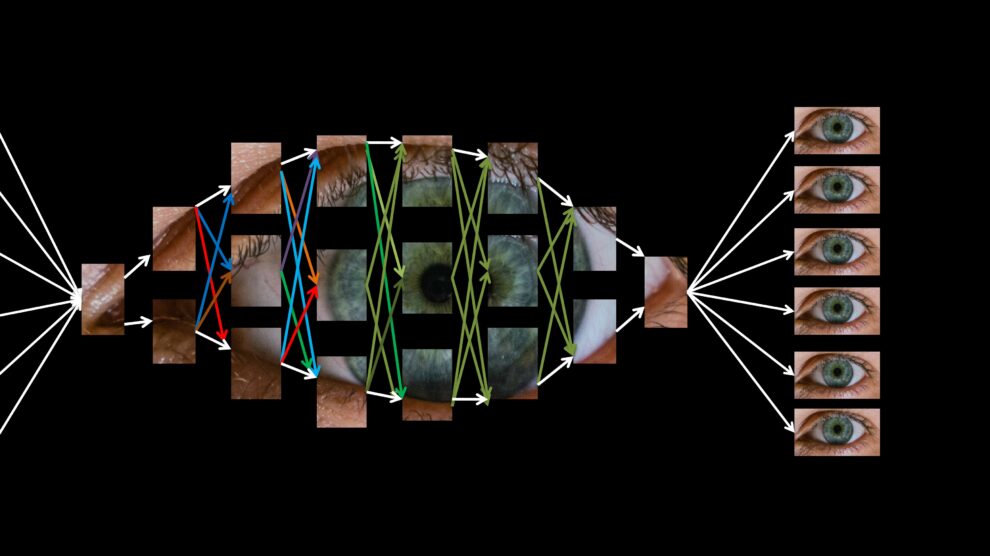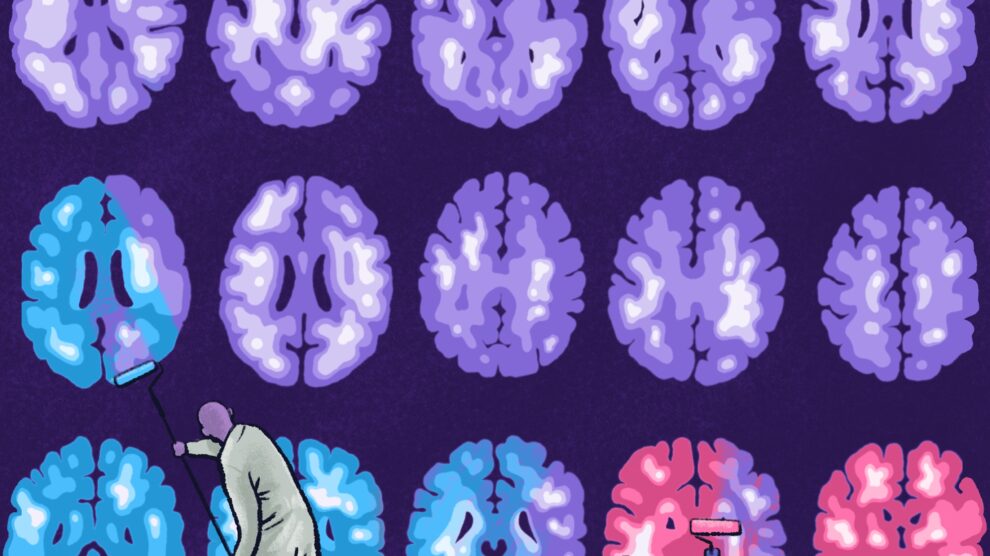The Biopolitics of Sex/Gender in Today’s Big Data and Computational Neuroscience
By Hannah Fitsch, Anelis Kaiser Trujillo, & Tino Plümecke
Volume 23, number 3, Bio-Politics

Along with genetics and genomics, the neurosciences currently share the dubious honor of being considered able to enlighten us on fundamental questions of human existence. One of these questions is the issue of sex/gender—in science, this boils down to an urge to explain whether women and men differ from each other. Comparisons of women versus men, along with distinctions related to racial or ethnic groups, have been among the most extensively investigated since the emergence of physical anthropology, psychopathology, and craniology in the nineteenth century. Yet despite the enthusiasm over empirical practices of knowledge production, the history of establishing sex/gender differences is both a history of failure and of constant renewal.
Regulation by Difference: A Feminist Critique of Neuroscience and Biopolitics
Within neuroscience, the debate about whether there is or is not a “natural” difference between women’s and men’s brains has been ongoing since the field’s inception. While early brain researchers suspected that women had brain fibers that were so delicate, they easily snapped, others later eagerly filled empty skulls with pearl barley to measure brain size and devoted large parts of their careers to weighing brains.1 Subsequently, women were thought to have smaller frontal and parietal lobes, then, a thicker corpus callosum, then, a thicker splenium, than men.2 Later, the modulative role of emotions in rational thinking was argued to operate differently in women and men.3 More recently, the connectivity between brain hemispheres was thought to be of crucial importance in distinguishing women’s brains from men’s.4 No matter how contradictory the research results have been, the implicit assumption of a difference that has yet to be discovered remains.
This eternal recurrence of the desire to identify sex/gender differences in the brain has been extensively analyzed in recent decades by countless feminist researchers, some of whom were also members of the first generation of Science for the People (Donna Haraway, Anne Fausto-Sterling, Hilary Rose). In recent years, feminist neuroscientists have successfully integrated feminist perspectives on difference into research on sex/gender and its intersected dimensions such as race, class, sexuality, or ability producing new conceptual frameworks, including neurofeminism and the mosaic brain.56789 These critical analyses and methodological interventions have provided convincing evidence that human brains are not dimorphic at the level of sex/gender. Why then, does the desire to prove that “female” and “male” brains are fundamentally different persist? And why do many researchers believe that the latest neuroscientific methods will ultimately uncover the difference?
Why then, does the desire to prove that “female” and “male” brains are fundamentally different persist?
To address this question, we take up the analytical conception of biopolitics developed by Michel Foucault, focusing on the iterative production of sex/gender differences in the neurosciences. In our view, it is not driven by new research findings but rather by a priori certainty of the existence of sexed/gendered difference and the heteronormative complementarity inscribed in the very foundations of our society. We understand the reification of the binary sex/gender dichotomy as being closely linked to its scientific investigation and to “relations of power” that “established it as a possible object.”10 In other words, sex/gender can be a target of power structures, “because techniques of knowledge [e.g., science] and procedures of discourse were capable of investing it.” The focus on biopolitics enables us to highlight the social nature of scientific fact-finding in the brain and, therein, the political functionalization of the search for a binary sex/gender. For this reason, we consider it important to analyze how contemporary neuroscience, and the notions of sex/gender inscribed into its questions, methods, and operationalizations, serves both to produce knowledge and to govern and regulate people and their behavior.
Regulation by Engineering: The Pretense of the New in the Eternal Same
Two significant subfields have emerged in the last forty years of neuroscience: computational and big data neuroscience. Computational neuroscience asks questions like: “what kind of computations does the brain make?” or “which algorithms does the brain use?” It models the brain as an information processing machine using methods from biophysics, dynamical and complex systems, and computer science to describe synapses, neurons, and neural networks. “Big data” science refers to the analysis of large data sets gathered from thousands of subjects. This field relies on recent massive increases in computing capacity that combs through data for common patterns and draws conclusions based on these computed patterns. Conceptually, both computational and big data neuroscience employ theoretical analyses and abstractions of the brain as they seek to understand principles that govern structure, physiology, and cognitive abilities of the nervous system. At times, distinctions between these fields are blurred, although computational neuroscience research can be carried out on small datasets, or without data at all. These newly developed methods have generated excitement for many neuroscience researchers who are ‘pivoting’ to the use of computational and big data methods in their own projects.
Because of these new characteristics in brain modeling and big data, we speak of an “engineered” brain—a brain composed and constructed of mathematical and electrical components, sequences of material states embedded in sets of apparatuses and programs. To illustrate this, let us take a look at a typical goal of a more “traditional” (not computational or big data) neuroscientific study and a more recent neuroscience study that uses these newer approaches. The older study examined whether sex/gender differences in regional brain volumes were associated with emotional regulation and reported findings of “sex differences in volume of temporo-limbic and frontal regions” of the brain.11 However, feminist neuroscientists demonstrated that studies like Gur’s with a small sample size are vulnerable to false positives; a meta-analysis of these studies demonstrates no reproducible sexual dimorphism findings.12
In big data neuroscience, datasets need not be taken from a single study with one specific question, but from a large number of previous studies with often quite different approaches and hypotheses. Like many others, a newer paper argues that a comprehensive study on developmental sex differences in brain connectivity requires a detailed analysis of a very large sample.4 While it is true that larger datasets can offer much better statistical power and yield improved scientific quality, the results still depend on the quality of the underlying dataset.13 Often, these data are shaped by a “publication bias” the skews towards publishing positive findings (here: showing difference) and against publishing null results, that is, studies demonstrating sex/gender similarity.1415 In addition, most computational algorithms fall back on classic taxonomic head size differences to achieve predictive power for sex. Since an algorithm conceals the various steps of the calculation process, it is even more difficult to comprehend the presuppositions and biases in producing outcomes. These structural problems can reinforce the dichotomous notions of “female” and “male” brains. Thus, supposed evidence for dimorphic brains can be carried over from small sample sizes, through dataset concatenation and opaque algorithms, can become (what appears to be) empirical reality.
The problems exist not only in the data, but also in the methods themselves, particularly methods that attempt to define a new “normal” by using pattern detection or clustering to construct “average females” and “average males”.16 For example, deep neural networks have become enormously popular as a way of identifying trends or characteristics in large datasets in an ‘unsupervised’ fashion—in a way, relieving the experimenter from responsibility for the results. These algorithms are often referred to as “black boxes,” as it is hard to understand which features of the data are used to make classifications or predictions. Although studies using deep neural networks tout their ability to classify “female” and “male” brains using brain scan images alone, their analyses do not reveal anything about how features of “female” and “male” brains are defined.17 Indeed, this classification may be based on small, complex clusters of brain “types” assigned to a sex/gender category, and not on the clear-cut binary some so desperately seek.
Neuroscientific praxis is changing, losing the individual, and with them, everything related to a reality of lived sex/gender: the complex interplay of identities, expressions, behaviors, and cognitions.
Neuroscientific praxis is changing, losing the individual, and with them, everything related to a reality of lived sex/gender: the complex interplay of identities, expressions, behaviors, and cognitions. When subjecting neuroscientific data to oversimplified sex/gender analyses, we risk collapsing human lived experience to a reductive, fleshless, and ultimately uninformative “F versus M” codification. Despite this, many are lured by the promise that, using these new methods, we will one day be able to predict sexed/gendered human actions, or even sex/gender identity, from imaging data.18 What could have been confined to the realm of neuroscience may one day be used to predict, and perhaps define, the meaning of sex/gender in humans.
The Need to Implement a Critical-Reflexive Approach
What does the relentless search for ultimate sex/gender difference in the brain, in individual nerve cells, in their smallest compartments and molecules tell us about our society, about the constitution of truth and thus of power in science? As we have shown, neuroscience is by no means merely a fact-finding exercise but is intrinsically political, just as the feminist science scholar Donna Haraway argued in regards to primatology: it is politics by other means.1920
This new way of understanding the brain through mathematical models and computed decision processes can be described as “algorithmic governmentality”.21 As Rouvroy and Berns wrote, “these algorithmic uses of statistics allow […] those systems to become mirrors of the most immanent normativities in society” and thus contribute “to (re)producing and multiplying this immanent normativity”. The recent popularity of “data-driven” approaches, in which the “hypotheses themselves are ‘generated’ from the data,” reduces and fragments the individual into a combination of statistically determined characteristics and behavioral patterns in an effort to extract “truth.”
What does the relentless search for ultimate sex/gender difference in the brain, in individual nerve cells, in their smallest compartments and molecules tell us about our society, about the constitution of truth and thus of power in science?
New technologies in many ways do generate new practices, new ways and possibilities of knowing, but they can also be used to perpetuate old practices, concepts, and paradigms like the male-female binary. Although current brain research no longer pursues the explicit goal of capturing the inferiority of women, as it did not so long ago, the paradigm of fundamental otherness of women remains. Knowledge about sex/gender difference cannot be purely descriptive, but instead creates its own biopolitical functionality in the repetition and, moreover, a legitimation of social reality. From a critical perspective on biopolitics, the differences projected with the means of computational neuroscience are prone to reaffirm and make plausible again and again the social differentiations observable in everyday life, and the social inequality along sex/gender. But in today’s neuroscientific data mining, these processes of categorical attribution can hardly be identified since the respective processes become invisible in the engineered brain. From a feminist perspective, it is necessary to critically accompany these entanglements of technologies, concepts, and scientific practices with an understanding of how the production of knowledge is paired with power-preserving strategies. Contrary to the prevailing essentialized understanding of biological knowledge as factual, stable, and timeless, the exact opposite is true, namely, that biological knowledge about sex/gender has always been articulated (and also contested) in the context of social and cultural norms.
We consider it necessary to understand the emergence of algorithmic governmentality as a contemporary form of biopolitics, and critical to develop biopolitical counter-strategies. To move towards feminist, anti-racist, anti-colonialist ends for science, we can develop and employ emancipative or “interventional” empirical methods that are appropriate for computational and big data approaches.22 Big data can have an advantage over the traditional smaller sample sizes in that it reduces the risk of false positives, particularly when effort has been put into standardizing large-scale data collection.23 Computationally-based clustering approaches can make possible more complex classifications beyond reductive “female” and “male” and offer paradigm-shifting models of understanding sex/gender.2425 Finally, the mere accessibility to big datasets—which means that a broader scientific community has open access to these data and can ask their own questions—can liberate the data from the purview of elite academics. However, such a research approach requires a historical, socio-critical, and situation-specific reflection on neuroscientific knowledge production. To achieve such critical concepts, we need to ask what a theory of the brain should look like so that the comprehension of the brain does not simply coincide with the spirit of capitalism.
Acknowledgments: We like to thank Katherine Bryant and Lindsey Thurston for their careful reading and helpful comments on previous versions of the manuscript. Thanks also to the German BMBF for the translation support (funding number 01GP1790).
About the Authors
Hannah Fitsch, PhD, studied Sociology, Biopsychology and New Media at Johann Wolfgang von Goethe University, Frankfurt am Main. She earned her PhD at the Technische Universität Berlin on visibilities and sayabilities in functional magnetic resonance imaging. Since 2012, she has been a teaching research assistant at the Center for Interdisciplinary Women and Genderstudies, TU Berlin. She holds a postdoctoral position at TU Berlin and her current project is titled, “How bodies turn into numbers and numbers into images: On algorithms in brain research and the logic of standardization.”
Anelis Kaiser Trujillo, PhD, is a professor for Gender Studies in STEM at the University of Freiburg.
Tino Plümecke, PhD, studied Sociology, Biology, and Gender Studies and is now a postdoctoral researcher at the University of Freiburg, Germany. He is co-investigator within the project Human Diversity in the New Life Sciences: Social and Scientific Effects of Biological Differentiations in which he deals with human differentiations in the life sciences, in particular in genetics and neurosciences. In addition, Tino’s work includes studies on theories of discrimination and critical race studies as well as, in the field of science and technology studies, on reflexive, critical, or interventional approaches in the life sciences.
References
- Cordelia Fine, Delusions of Gender: How Our Minds, Society, and Neurosexism Create Difference (New York, New York: W.W. Norton & Company, 2010).
- Anne Fausto-Sterling, Sexing the Body: Gender Politics and the Construction of Sexuality (New York, New York: Basic Books, 2000).
- Robyn Bluhm, “Self-Fulfilling Prophecies: The Influence of Gender Stereotypes on Functional Neuroimaging Research on Emotion”, Hypatia 28, no. 4 (2013): 870–86.
- Madhura Ingalhalikar et al., “Sex Differences in the Structural Connectome of the Human Brain,” Proceedings of the National Academy of Sciences 111, no. 2 (2013): 823–28, https://doi.org/10.1073/pnas.1316909110.
- Gina Rippon, Rebecca Jordan-Young, Anelis Kaiser, and Cordelia Fine, “Recommendations for Sex/Gender Neuroimaging Research: Key Principles and Implications for Research Design, Analysis, and Interpretation,” Frontiers in Human Neuroscience 8 (2014), https://doi.org/10.3389/fnhum.2014.00650.,
- Deboleena Roy, Molecular Feminisms: Biology, Becomings, and Life in the Lab (Seattle, Washington: University of Washington Press, 2018).,
- Hannah Fitsch and Kathrin Friedrich, “Digital Matters: Processes of Normalization in Medical Imaging,” Catalyst 4, no. 2 (2018): 1–31.,
- Diana Schellenberg and Anelis Kaiser, “The Sex/Gender Distinction: Beyond f and m,” in History, Theory, and Battlegrounds, 165–87 (Washington: American Psychological Association, 2020).,
- Daphna Joel, “Male or Female? Brains are Intersex,” Frontiers in Integrative Neuroscience 5, no. 57 (2011): 1–5.
- Michel Foucault, The History of Sexuality (New York, New York: Pantheon Books, 1978).
- Ruben C. Gur, Faith Gunning-Dixon, Warren B. Bilker, and Julie Patel, “Sex Differences in Temporo-Limbic and Frontal Brain Volumes of Healthy Adults,” Cerebral Cortex 12, no. 9 (2002): 998-1003.
- Lise Eliot, Adnan Ahmed, Hiba Khan, and Julie Patel, “Dump the ‘Dimorphism’: Comprehensive Synthesis of Human Brain Studies Reveals Few Male-Female Differences Beyond Size,” OSF Preprints, August 7, 2020, https://osf.io/syd7z/.
- Scott Marek et al., “Towards Reproducible Brain-Wide Association Studies,” BioRxiv, August 22, 2020, https://doi.org/10.1101/2020.08.21.257758.
- Anelis Kaiser, Sven Haller, Sigrid Schmitz, and Cordula Nitsch, “On Sex/Gender Related Similarities and Differences in fMRI Language Research,” Brain Research Reviews 12, no. 2 (2009): 49–59.,
- Sean P. David et al., “Potential Reporting Bias in Neuroimaging Studies of Sex Differences,” Scientific Reports 8, no. 1 (2018): 6082.
- Benson Mwangi, Jair C. Soares, and Khader M. Hasan, “Visualization and Unsupervised Predictive Clustering of High-Dimensional Multimodal Neuroimaging Data,” Journal of Neuroscience Methods 236 (2014): 19–25.
- Cordelia Fine and Carla Sanchis-Segura, “Are There ‘Male’ and ‘Female’ Brains? Computers Can See a Distinction, But They Rely Strongly on Differences in Head Size,” The Conversation (2020), https://theconversation.com/are-there-male-and-female-brains-computers-can-see-a-distinction-but-they-rely-strongly-on-differences-in-head-size-143972.
- Benjamin Clemens et al., “Predictive Pattern Classification Can Distinguish Gender Identity Subtypes from Behavior and Brain Imaging,” Cerebral Cortex 30, no. 5 (May 14, 2020): 2755–65, https://doi.org/10.1093/cercor/bhz272.
- Isabelle Dussauge and Anelis Kaiser, “Neuroscience and Sex/Gender.” Neuroethics 5, no. 3 (2012): 211–215.,
- Donna J. Haraway, “Primatology Is Politics by Other Means,” in Feminist Approaches to Science, ed. Ruth Bleier (New York: Pergamon, 1986), 77–118.
- Antoinette Rouvroy and Thomas Berns. “Algorithmic Governmentality and Prospects of Emancipation,” Réseaux 177, no. 1 (2013).
- Katherine Bryant, Giordana Grossi, and Anelis Kaiser, “Feminist Interventions on the Sex/Gender Question in Neuroimaging Research,” The Scholar & Feminist Online 15, no. 2 (2019).
- The International Brain Laboratory et al., “Standardized and Reproducible Measurement of Decision-Making in Mice,” BioRxiv, October 9, 2020, https://doi.org/10.1101/2020.01.17.909838.
- Daphna Joel et al., “Sex Beyond the Genitalia: The Human Brain Mosaic,” PNAS 112, no. 50 (2015): 15468–15473.,
- Daphna Joel and Anne Fausto-Sterling, “Beyond Sex Differences: New Approaches for Thinking about Variation in Brain Structure and Function,” Philosophical Transactions of the Royal Society B: Biological Sciences 371, no. 1688 (February 19, 2016): 20150451, https://doi.org/10.1098/rstb.2015.0451.





